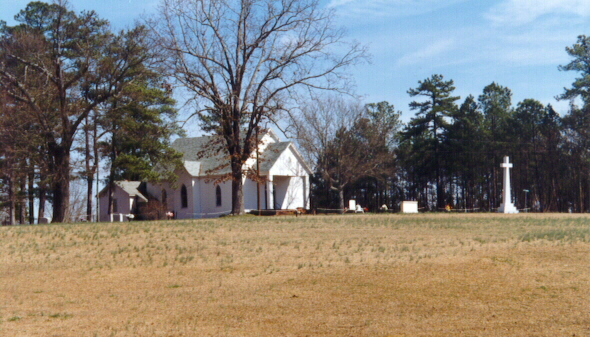Mt. Croghan
 Mt.
Croghan was named after a French officer of the Revolutionary War, Major
Croan. On his way to Virginia, after the Battle of Camden, he and his men
camped on the hill overlooking the present town, were the Methodist Church
is now. Mt.
Croghan was named after a French officer of the Revolutionary War, Major
Croan. On his way to Virginia, after the Battle of Camden, he and his men
camped on the hill overlooking the present town, were the Methodist Church
is now.
However, the territory had long been a settled area of Chesterfield
County, with many of the original families moving in along the North Carolina/South
Carolina line. Located here was an important crossroads. Traveling north
would take one to Hailey's Ferry crossing the PeeDee River; traveling south
would take you to Camden, and the east-west road connected Cheraw with
Lancaster. Now Highway 9, this was an old Indian path connecting the Cheraw
indian village with that of the Waxhaws.
Robert Parton and Gustavieus Hendricks were two of the first in the
area to receive land grants. Both later sold their land to Joel Meadows
(Meadors). By 1809, Mt. Croghan was a voting precinct and had its on post
office. After the death of Joel, his widow married Samuel Shelby, who sold
the land to James Fields in 1822. The next year he in turn sold the land
to Judge Josiah Evans of Society Hill. Turner Bryan bought the land next
and by 1834, had built a blacksmith shop, a store, and the School House
on Spring Branch. In 1836, The Elizabeth Academy was built across from
Elizabeth Baptist Church, which was founded in 1819. The academy was considered
a prestigious High School which taught Latin, Violin, History, Geography,
the three R's among other subjects. This property is north of the current
town site on the Maysville Road. The land, except for the 10 acres that
the blacksmith shop and store were on, then passed to Turner's son-in-law,
Francis Johnson, who died by 1855.
The town continued to grow until the destruction experienced when Sherman's
Army came through. After the War, Mt. Croghan once again began steady growth,
mostly dependant upon agriculture. By the early 1900's there were eight
to ten stores.
On October 3, 1911, J.C. Burch, T.M. Moore, C.F. Taylor, J.O. Taylor,
J.H. Timmons, N.T. Rivers, J.S. Funderburk, W.A. Rivers, and J.N. Ratliff
, submitted the paperwork to have the town of Mt. Croghan incorporated,
which was approved by the Secretery of State, R.M. McCown on May 28, 1914.
At that time, the stated population was 150.
Mayor Charles L. Burch said in the 1940's, Mt. Croghan had four service
stations, a barber shop, a Post Office, a drug store, a cement plant, a
brick plant, two cotton gins, a stationary saw mill, a corn mill, seven
grocery stores, one hardware store, and River's Auto. Now only the Post
Office and a store is left. Ruby Manufacturing still produces a little,
but on the whole, employment is found in the surrounding towns and cities.
He is proud of the improvements achieved in recent years and in particularly
proud that there are no town taxes. The population as of 1990 was 131 residents.
 Also,
the buildings that are left in Mt. Croghan face Highway 9 as it is today.
The older portion of town faced the road behind the service station, which
is appropriately named Old Lancaster Highway. The brick bank and other
buildings are no longer there. Also,
the buildings that are left in Mt. Croghan face Highway 9 as it is today.
The older portion of town faced the road behind the service station, which
is appropriately named Old Lancaster Highway. The brick bank and other
buildings are no longer there.
Highway 9 Looking East Through Mt.
Croghan
|